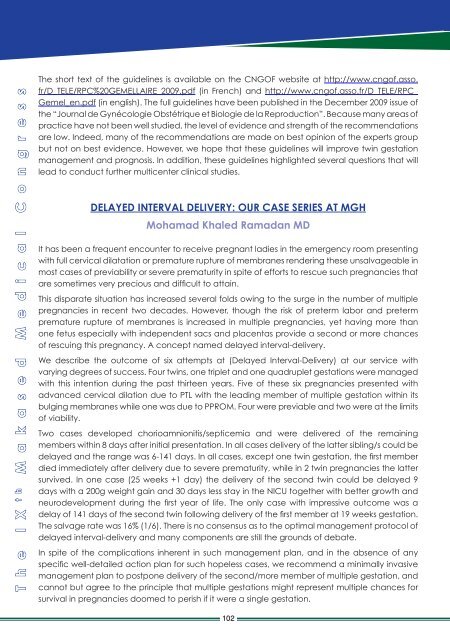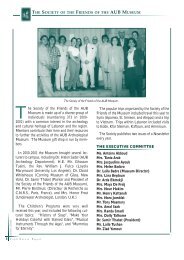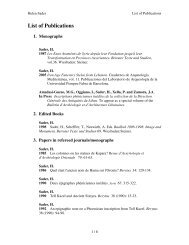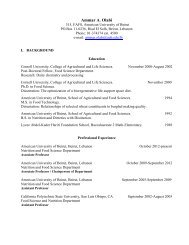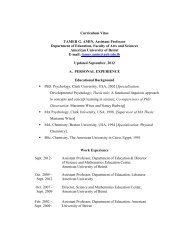The IX t h Makassed Medical Congress - American University of Beirut
The IX t h Makassed Medical Congress - American University of Beirut
The IX t h Makassed Medical Congress - American University of Beirut
You also want an ePaper? Increase the reach of your titles
YUMPU automatically turns print PDFs into web optimized ePapers that Google loves.
T h e I X t h M a k a s e d M e d i c a l C o n g r e s s<br />
<strong>The</strong> short text <strong>of</strong> the guidelines is available on the CNGOF website at http://www.cng<strong>of</strong>.asso.<br />
fr/D_TELE/RPC%20GEMELLAIRE_2009.pdf (in French) and http://www.cng<strong>of</strong>.asso.fr/D_TELE/RPC_<br />
Gemel_en.pdf (in english). <strong>The</strong> full guidelines have been published in the December 2009 issue <strong>of</strong><br />
the “Journal de Gynécologie Obstétrique et Biologie de la Reproduction”. Because many areas <strong>of</strong><br />
practice have not been well studied, the level <strong>of</strong> evidence and strength <strong>of</strong> the recommendations<br />
are low. Indeed, many <strong>of</strong> the recommendations are made on best opinion <strong>of</strong> the experts group<br />
but not on best evidence. However, we hope that these guidelines will improve twin gestation<br />
management and prognosis. In addition, these guidelines highlighted several questions that will<br />
lead to conduct further multicenter clinical studies.<br />
DELAYED INTERVAL DELIVERY: OUR CASE SERIES AT MGH<br />
Mohamad Khaled Ramadan MD<br />
It has been a frequent encounter to receive pregnant ladies in the emergency room presenting<br />
with full cervical dilatation or premature rupture <strong>of</strong> membranes rendering these unsalvageable in<br />
most cases <strong>of</strong> previability or severe prematurity in spite <strong>of</strong> efforts to rescue such pregnancies that<br />
are sometimes very precious and difficult to attain.<br />
This disparate situation has increased several folds owing to the surge in the number <strong>of</strong> multiple<br />
pregnancies in recent two decades. However, though the risk <strong>of</strong> preterm labor and preterm<br />
premature rupture <strong>of</strong> membranes is increased in multiple pregnancies, yet having more than<br />
one fetus especially with independent sacs and placentas provide a second or more chances<br />
<strong>of</strong> rescuing this pregnancy. A concept named delayed interval-delivery.<br />
We describe the outcome <strong>of</strong> six attempts at (Delayed Interval-Delivery) at our service with<br />
varying degrees <strong>of</strong> success. Four twins, one triplet and one quadruplet gestations were managed<br />
with this intention during the past thirteen years. Five <strong>of</strong> these six pregnancies presented with<br />
advanced cervical dilation due to PTL with the leading member <strong>of</strong> multiple gestation within its<br />
bulging membranes while one was due to PPROM. Four were previable and two were at the limits<br />
<strong>of</strong> viability.<br />
Two cases developed chorioamnionitis/septicemia and were delivered <strong>of</strong> the remaining<br />
members within 8 days after initial presentation. In all cases delivery <strong>of</strong> the latter sibling/s could be<br />
delayed and the range was 6-141 days. In all cases, except one twin gestation, the first member<br />
died immediately after delivery due to severe prematurity, while in 2 twin pregnancies the latter<br />
survived. In one case (25 weeks +1 day) the delivery <strong>of</strong> the second twin could be delayed 9<br />
days with a 200g weight gain and 30 days less stay in the NICU together with better growth and<br />
neurodevelopment during the first year <strong>of</strong> life. <strong>The</strong> only case with impressive outcome was a<br />
delay <strong>of</strong> 141 days <strong>of</strong> the second twin following delivery <strong>of</strong> the first member at 19 weeks gestation.<br />
<strong>The</strong> salvage rate was 16% (1/6). <strong>The</strong>re is no consensus as to the optimal management protocol <strong>of</strong><br />
delayed interval-delivery and many components are still the grounds <strong>of</strong> debate.<br />
In spite <strong>of</strong> the complications inherent in such management plan, and in the absence <strong>of</strong> any<br />
specific well-detailed action plan for such hopeless cases, we recommend a minimally invasive<br />
management plan to postpone delivery <strong>of</strong> the second/more member <strong>of</strong> multiple gestation, and<br />
cannot but agree to the principle that multiple gestations might represent multiple chances for<br />
survival in pregnancies doomed to perish if it were a single gestation.<br />
102


